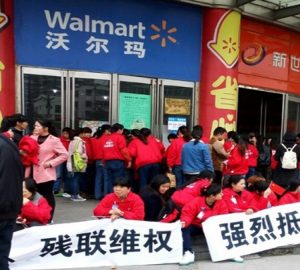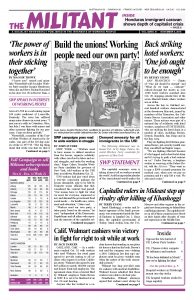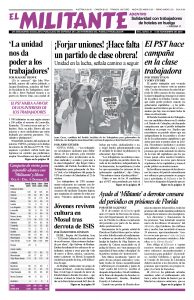
The U.S. capitalist rulers continue to seek ways to contain Beijing, the world’s second largest capitalist economy, in their cut-throat battle over which of the capitalist rulers can appropriate more of the wealth created by working people around the world.
Washington remains the stronger power today, but they do face increasing competition. The Donald Trump administration complains that Beijing uses state resources to uncut the U.S. bosses and plans to extend additional tariffs on Chinese imports prior to a November summit between Trump and Chinese President Xi Jinping.
The White House argues that Washington’s 10 percent tariff on $200 billion of Chinese imports will “put America first in trade so American workers aren’t put at a disadvantage.” His measures have drawn praise from AFL-CIO President Richard Trumka.
“In reality the government puts American bosses first at home and abroad,” James Harris, Socialist Workers Party candidate for U.S. Senate from Maryland, said. “These are the very same employers who have eroded wages and imposed worse conditions on workers here. The government’s claim to defend workers is in fact an attempt to tie working people to those who exploit us at home and set us against fellow workers in China and elsewhere. Damage from the tariffs falls hardest on working people. The SWP unconditionally opposes Washington’s tariffs.”
Referring to the rising “great power competition” between Washington and Beijing, Vice President Michael Pence claimed Oct. 4 that Beijing wanted “nothing less than to push the United States of America from the Western Pacific.” The administration, he vowed, would “continue to assert American interests across the Indo-Pacific.”
The U.S. capitalist rulers viewed China and Asia as their biggest prize as victor in the second imperialist world war. They dreamed of decades of exploiting markets, minerals and labor there.
Washington imagined this would include snatching China from the hands of the defeated Japanese colonial rulers, but both Chinese toilers and U.S. workers in the armed forces had other ideas. As the war drew to a close in 1945 tens of thousands of U.S. soldiers in the Philippines and elsewhere in Asia protested against Washington’s intervention in the civil war developing in China, demanding to go home. They won widespread support among working people in the U.S. and Washington was forced to bring them home. The rule of U.S.-backed Chiang Kai-shek was overturned by workers and peasants in China in 1949.
After decades of Maoist Stalinist rule, the state-run economy and social relations deteriorated, and the Chinese rulers in the late 1970s turned increasingly to the use of capitalist methods. Once again, the U.S. propertied owners hoped that China would become a new arena for investment and for markets they would dominate. But in practice the Chinese rulers have turned into the U.S. rulers’ biggest competitor across Asia, in Africa and elsewhere. Most importantly in the long run, the transformation of a largely peasant economy to one based increasingly on capitalist production and trade accelerated the growth of a working class that has begun resisting the conditions it toils under and pressing for union rights.
Today the U.S. administration’s use of tariffs wields the massive weight of the U.S. economy to gain advantage against Chinese capitalists, including the dollar’s unchallenged place as the world’s number one currency.
Washington has stepped up U.S. navy patrols in areas of the South China Seas that Beijing claims. It has signed new trade deals with Mexican and Canadian governments that penalize them if they sign a trade pact with Beijing. And the White House has increased restrictions on the sale of nuclear technology to China by U.S. companies.
With bipartisan support the administration rolled out a $60 billion loan program to capitalist governments in Asia, Africa and Latin America designed to undercut Beijing’s mounting influence.
China’s ‘Belt and Road Initiative’
The Chinese rulers are pushing what they call a Belt and Road Initiative of loans, transportation projects, sea lanes and massive construction projects in more than 60 countries to increase Chinese capitalists’ access to profits, influence and trade.
In the early stages of the project, Chinese bosses have already secured more than $340 billion in construction contracts.
Many weaker capitalist government drawn into the “initiative” are finding themselves caught up in expanding debt, including Djibouti, Kyrgyzstan, Laos, Mongolia, Pakistan and others. Debts forced the Sri Lankan rulers to turn their main seaport over to Beijing for the next 99 years.
Liberals and others who despise the Trump administration — and the workers who they see as responsible for it — paint Washington’s efforts to take on Beijing as a destabilizing departure from global collaboration and previous administrations’ efforts to slow down Beijing’s expansion. Papers like the New York Times are full of talk of the opening of a China-U.S. Cold War.
But many among the U.S. ruling families anticipate Trump’s measures can effectively pressure Beijing, as Chinese bosses are more dependent on access to U.S. markets than their U.S. rivals are to markets in China.
While the U.S. capitalist rulers and Beijing continue their rivalry, the most important change brought about by the development of capitalism in China — the massive expansion of the working class — will place its mark on politics there.
Unlike the conditions that existed across most of Asia, Africa and Latin America at the end of World War II, when millions of toilers lived outside capitalist social relations, workers there today have been transformed by the development of capitalist production and trade, accompanying class differentiation, and the huge growth of the working class. The question posed in the decades ahead will not be which of the capitalist classes — the U.S. or Chinese — will prevail, but whether the working class, as it strives for independent political organization, will overturn capitalist exploitation and oppression and take control of the wealth they produce into their own hands.

